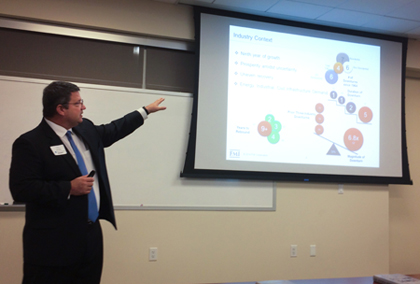 Recently at the annual Kiley Advisors Update Conference for construction industry owners in Houston, keynote speaker Christopher Daum, the President and CEO of FMI Corporation, discussed the ownership succession issues facing those current owners of construction companies, especially private family-owned sub contractors, as they come to the end of their careers and begin to wonder what will happen to their companies after they are gone. Though no one in the room would admit to it, many are at the end of the road looking for succession options at a time when we are all living in a VUCA (volatile, uncertain, complex, ambiguous) world made even more so by the cyclical nature of the construction industry and the demographics of the workforce that contains their future partners or owners.
Recently at the annual Kiley Advisors Update Conference for construction industry owners in Houston, keynote speaker Christopher Daum, the President and CEO of FMI Corporation, discussed the ownership succession issues facing those current owners of construction companies, especially private family-owned sub contractors, as they come to the end of their careers and begin to wonder what will happen to their companies after they are gone. Though no one in the room would admit to it, many are at the end of the road looking for succession options at a time when we are all living in a VUCA (volatile, uncertain, complex, ambiguous) world made even more so by the cyclical nature of the construction industry and the demographics of the workforce that contains their future partners or owners.
Daum explored and examined a number of possibilities for ownership succession in detail, but he made one point that hit several of the owners in the audience right between the eyes. He said, “Boomers have waited too long to develop a succession plan if they are not already executing one.” His point is that ownership succession is a process that takes 10-15 years to complete, unless it is a pure buyout. He made several other points that caused the owners in the audience to sit up and take notice. He said that current Boomer owners of those “privately held” and/or “family-owned” construction companies need to heed the demographics of the potential ownership of their companies as they make the transition.
He noted that the majority of the current owners of construction companies will retire in the next 5-7 years and that the Millennials, not the Gen Xers, will be the next owners of those construction companies that survive. When asked why the Gen Xers were not the logical “turn to” folks for succession, he said that there are not enough of them and that the Millennials both outnumbered the Boomers and the Gen Xers in the construction workforce and in the population. He punctuated that point by saying that “Demographics determine construction budgets.”
He made a solid point that “We are in year 10 of a 6 year cycle for a recession” and that creating a workable succession plan in the middle of a recession, likely to happen in the next 3 years, would be difficult. He offered some hope to the Houston audience in that he feels that the construction industry in Texas will “not participate in the next recession.” He pinned that point by saying that the influx of new population into Texas would fuel the construction industry at a time when most of the rest of the country would be fighting to keep their businesses afloat.
He went further to say that the construction industry is in an “immigration dependent future.” Essentially that our continued growth will depend on the influx of immigrants, both domestic and foreign to fuel construction as well as to create construction workers. His advice was that “Texas has to get ready to meet the influx of new residents and immigrants.”
Daum explained that there were essentially three ways to get out of the construction company that you own today. First is to sell outright, cash out and retire to your ranch. Second is to transfer your ownership to your employees or partners with some buyout plan like an ESOP. The third is to liquidate the business by selling the “hard assets” and closing the doors.
In taking the first avenue, Daum told the group that “the big firms are getting bigger” by buying other firms to fill the gaps in their business and to expand into other business lines that will grow to provide new markets for the future. The oil and gas business is going through that process today. One of the latest examples is the GE pending acquisition of Baker Hughes. Daum also said that foreign firms with lots of cash are buying US firms. This is especially evident in the recent moves by some Chinese construction firms looking for expansion into the US market. They believe that the US market will remain viable and they want to establish a market presence and begin to bid jobs in the US market in competition with existing firms. Buying viable firms is one way to accomplish that goal.
The second route of transferring ownership to your employees or partners is the one that takes a longer period to accomplish. It is important to have experienced advisors to help you layout a plan, especially if you are a sole owner of a mid sized or family owned business. Currently there are 250 ESOPs in the construction industry, partially the result of the nature of construction companies having grown up as family-owned businesses run by Boomers who are now searching for a way to accomplish the transition in a timely manner.
Daum clearly brought a serious view to the program that was fueled by his firm’s experience as advisors and investment bankers for the construction industry. The owners in the audience clearly left the program with new knowledge and a view of the future that gave them potential options for succession planning for their businesses.


